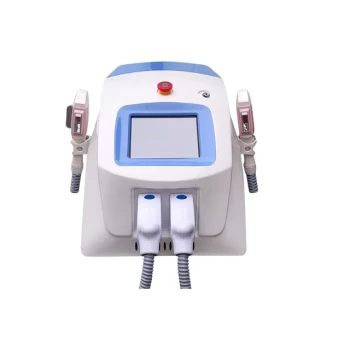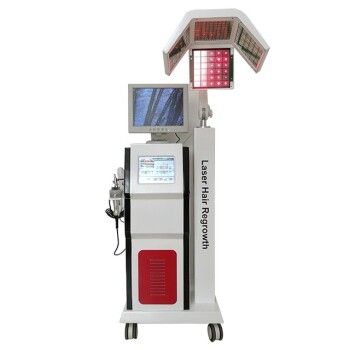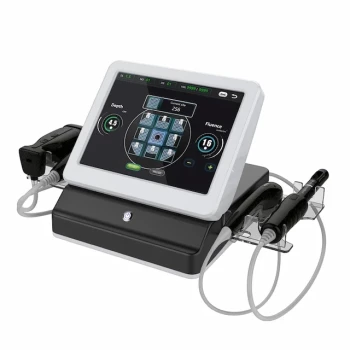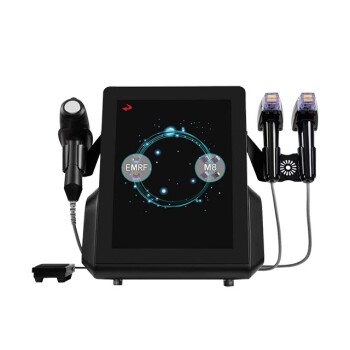Yes, shaving before using a light-based hair removal device is a mandatory step. This is not an optional suggestion; it is fundamental to the safety and effectiveness of the treatment. Failing to shave directs the device's energy to the hair above the skin rather than the follicle below it, which wastes the treatment and creates a significant risk of skin burns.
Shaving is non-negotiable because light-based hair removal works by targeting the dark pigment within the hair follicle. Any hair above the skin's surface will intercept the light energy, preventing it from reaching the root and turning a therapeutic tool into a source of surface-level heat.
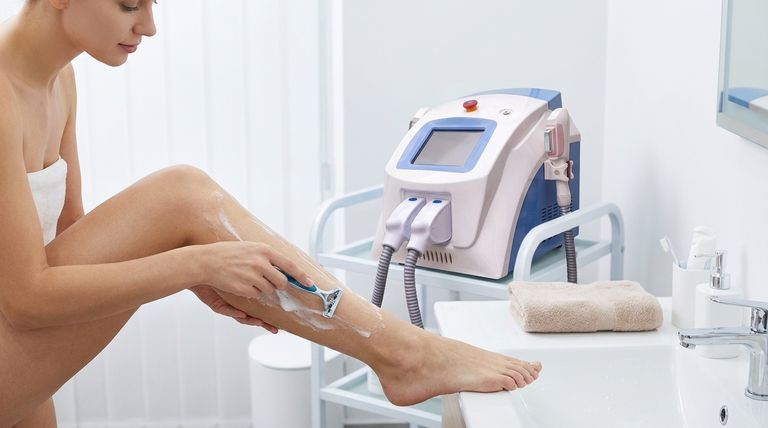
How Light-Based Hair Removal Actually Works
To understand why preparation is so critical, you first need to understand the mechanism of the device itself. It's a precise process that relies on a clear path to its target.
Targeting Melanin in the Follicle
Light-based devices, such as IPL or laser, emit a powerful pulse of light energy. This energy is specifically absorbed by dark pigment, or melanin, which is highly concentrated in the hair shaft and its root.
When the melanin absorbs this intense light, the energy instantly converts to heat. This targeted heat is what damages the hair follicle, disrupting its growth cycle and inhibiting its ability to produce new hair.
The Problem with Surface Hair
The device cannot distinguish between the hair you see on the surface and the follicle hidden beneath. It simply sends energy toward the highest concentration of melanin it can find.
If hair exists above the skin, it acts as the primary target. It absorbs all the energy on the surface, effectively blocking the light from ever reaching the follicle below.
The Critical Reasons for Shaving Before Treatment
Shaving is the only preparation method that leaves the critical part of the hair (the root in the follicle) intact while removing the obstructive part (the hair on the surface).
To Maximize Energy Delivery
Shaving clears the way, creating a direct path for the light energy to travel down the short, blunt-ended hair stubble directly to the follicle. This ensures the maximum amount of thermal energy is delivered precisely where it's needed to be effective.
To Prevent Surface Skin Burns
When long hair on the surface absorbs the device's intense energy, it instantly singes. This burning hair lies directly against your skin, which can easily cause pain, redness, and superficial burns.
To Avoid Unpleasant Odors
The distinct and unpleasant smell of burning hair is a direct and immediate consequence of treating an unshaven area. This is a clear sign that the device's energy is being wasted on the surface.
Common Pitfalls and Best Practices
Avoiding common mistakes is just as important as following the correct procedure. Understanding what not to do protects your skin and ensures you get the results you're investing in.
Why You Must Shave, Not Wax or Epilate
Methods like waxing, tweezing, or epilating are counterproductive because they remove the entire hair shaft from the follicle. Without the hair acting as a conduit for the light energy, the treatment has nothing to target and will be completely ineffective.
The Importance of Proper Timing
For ideal results, shave within 24 hours before your treatment. Shaving as close to the session as is comfortable for your skin is often best. This leaves the follicle intact with just enough stubble below the surface to be an excellent target.
The Risk of Shaving with a Dull Razor
Using a dull razor or shaving against the grain can cause micro-abrasions, razor burn, or irritation. Applying intense light and heat to already-irritated skin can amplify discomfort and lead to adverse reactions.
Your Pre-Treatment Preparation Checklist
To ensure every session is safe, comfortable, and maximally effective, follow this simple protocol.
- If your primary focus is maximum effectiveness: Shave with a clean, sharp razor as close to your treatment time as your skin comfortably allows.
- If your primary focus is avoiding skin irritation: Shave 12-24 hours prior to treatment, always move the razor with the grain of hair growth, and ensure the skin is completely clean and dry before use.
- If your primary focus is consistent results: Confirm you have not waxed, epilated, or tweezed the area for at least four weeks to ensure every follicle contains a hair to treat.
Proper preparation is the key to unlocking the full potential of your hair removal device safely and efficiently.
Summary Table:
| Preparation Step | Purpose | Why It's Critical |
|---|---|---|
| Shave Before Use | Clear path for light energy | Targets the follicle, not surface hair, preventing burns and ensuring effectiveness. |
| Avoid Waxing/Epilating | Keep follicle intact | These methods remove the hair root, leaving nothing for the light energy to target. |
| Use a Sharp Razor | Prevent skin irritation | A dull razor can cause micro-abrasions, increasing discomfort during treatment. |
Achieve professional-grade, safe hair removal results for your clinic or salon.
BELIS specializes in providing medical aesthetic clinics and premium beauty salons with professional, reliable hair removal equipment. Our devices are engineered for maximum safety and efficacy when used with the correct protocols, like pre-treatment shaving.
Let us help you enhance your service offerings and client satisfaction. Contact our experts today to find the perfect professional solution for your business.
Visual Guide
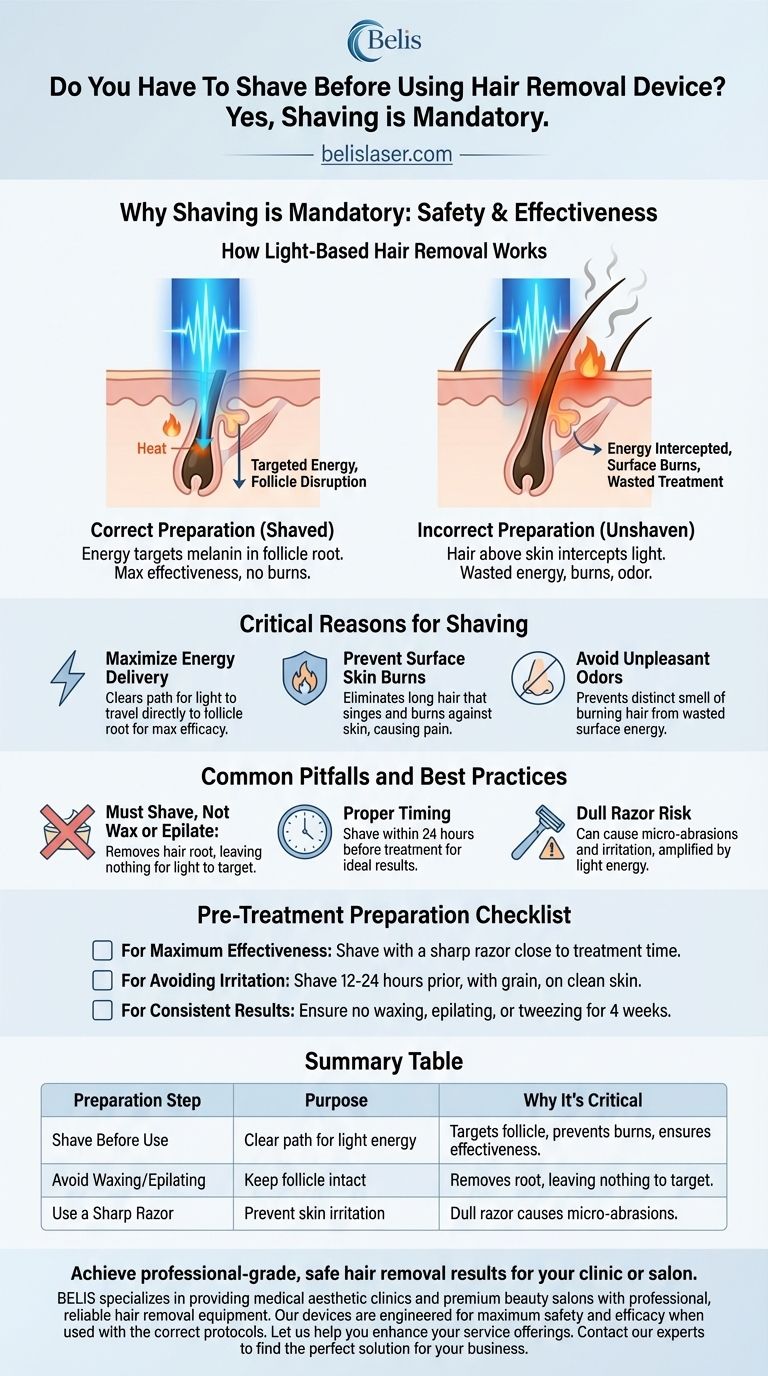
Related Products
- IPL SHR Hair Removal Machine for Permanent Hair Removal
- Clinic Diode Laser Hair Removal Machine with SHR and Trilaser Technology
- Trilaser Diode Hair Removal Machine for Beauty Clinic Use
- Diode Laser SHR Trilaser Hair Removal Machine for Clinic Use
- Clinic Use IPL and SHR Hair Removal Machine with Nd Yag Laser Tattoo Removal
People Also Ask
- What is intense pulsed light good for? A Versatile Solution for Sun Spots, Redness, and Hair
- Can you use hair removal device on private parts? A Guide to Safe Bikini Area IPL
- Does IPL hair removal actually work? Achieve Long-Term Hair Reduction
- Does IPL hair removal really work? Unlock Long-Term Hair Reduction with Science
- How quickly do you see IPL results? A Realistic Timeline for Clearer Skin
